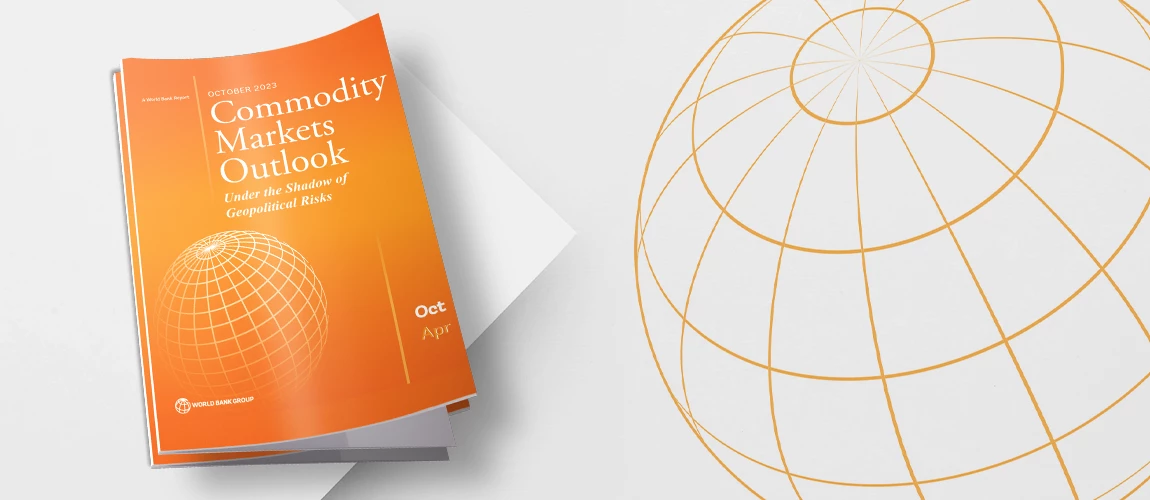 Global food prices have been trending downward during the past three quarters.
Global food prices have been trending downward during the past three quarters.
This blog post is part of a special series based on the October 2023 Commodity Markets Outlook, a flagship report published by the World Bank. This series features concise summaries of commodity-specific sections extracted from the report.
Global food prices have been trending downward during the past three quarters. The World Bank’s food price index, which declined 9 percent in 2023 compared to 2022, is expected to fall a further 2 percent in 2024 and an additional 3 percent in 2025. Good crop conditions and lower input costs, despite headwinds including El Niño, have pushed global food prices down. However, there are numerous risks to the outlook, as discussed in what follows.
Middle East Conflict
A key risk to food prices relates to an escalation of the conflict in the Middle East. A sustained oil price spike, resulting from an escalation of the conflict, would raise food prices by increasing production and transportation costs for food and fertilizers, as seen during earlier oil price spikes. Additionally, fertilizer prices could increase if natural gas and coal prices rise markedly, as these are key inputs to fertilizer production, or if the conflict spreads and involves large exporters of nitrogen-based fertilizers in the region.
El Niño
The 2023-24 El Niño is expected to peak this winter and gradually diminish by spring 2024. Following historical trends, the World Bank’s food price forecasts for 2024 anticipate El Niño to lead to higher prices of agricultural commodities, particularly for tropical crops such as cocoa, food oils, natural rubber, rice, and sugar. These crops are predominantly produced in regions where El Niño typically causes dry conditions, including Africa (notably in the northeast, southern, and Sahel region), Asia (in the south and southeast), Central America, and Australia. However, no two El Niños are the same in their strength. A weaker-than-expected El Niño, or muted effects of El Niño due to its interactions with short-term weather patterns, pose a downside risk to agricultural prices.
Export restrictions
In July, India banned the export of non-basmati rice, a preemptive move driven by concerns about the impacts of El Niño. This policy move has contributed to rising rice prices. However, an easing of these restrictions, potentially due to better-than-expected weather conditions, could help stabilize rice prices. India accounts for 40 percent of the world’s rice exports. There is also a risk that India might impose export restrictions on sugar--another commodity for which the country is a major exporter.
Black Sea Grain Initiative
While Russia’s withdrawal from the Black Sea Grain Initiative introduced disruptions of grain exports from the Black Sea, the forecast assumes that grains will continue to flow out of Ukraine. However, should hostilities from the invasion of Ukraine intensify or if the Danube River becomes unnavigable, grain and oilseed markets could tighten, leading to upward price pressure.
Macroeconomic conditions
Central banks’ interest rate hikes aimed at curbing inflation have increased the cost of capital, potentially restricting borrowing and investment in agricultural sectors and exports. Sluggish worldwide growth might result in subdued demand and reduced prices for agricultural goods, particularly raw materials. In addition, currency fluctuations against the U.S. dollar, with many local currencies depreciating, play a role in local market food price inflation.
Climate Change
In the longer term, the increased frequency of extreme weather events, such as heat waves, floods, storms, droughts, hurricanes, wildfires, and worsening water scarcity, pose upside price risks to agricultural commodities. The interaction of El Niño and global warming could make 2024 break the extreme temperature records set in 2023, potentially rattling food prices.
In conclusion, while global food prices have been on a downward trend in recent quarters, a few risks could impact this outlook. The escalation of conflict in the Middle East, particularly if it leads to a sustained oil price spike, could increase production and transportation costs for food and fertilizers. The current El Niño is expected to lead to higher prices for agricultural commodities, especially tropical crops, due to dry conditions in key producing regions. Export restrictions, such as India's ban on non-basmati rice, have already caused price increases, but an easing of these restrictions could stabilize prices. Disruptions in grain exports from the Black Sea and macroeconomic conditions, including interest rate hikes and currency fluctuations, also pose risks to food prices. Furthermore, the long-term impact of climate change, including extreme weather events and worsening water scarcity, could further impact agricultural commodity prices. We will continue to monitor these risks and their potential effects on global food prices in the coming years.



Join the Conversation